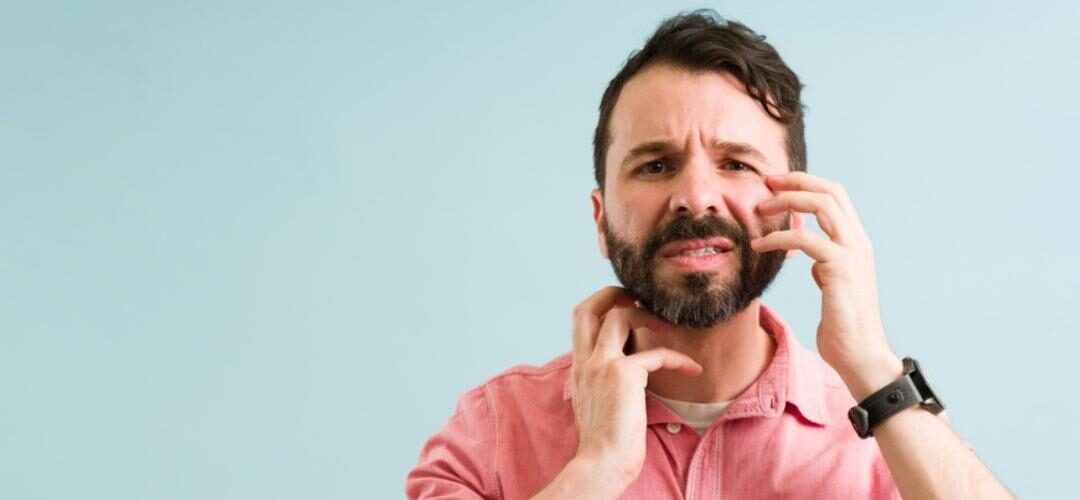Irritating skin conditions are one of the most common health conditions affecting people worldwide. Whether it’s acne, eczema or rosacea, chances are you or someone you know is dealing with one of these skin concerns.
Globally, around 6% of the adult population is affected by rosacea. Although rosacea is more common in women, when men are affected by the condition the symptoms are likely to be more severe in nature.
What is rosacea?
Rosacea is an inflammatory skin condition that can appear on the surface of the face or eyes. Scientifically speaking, there is no clear or determined cause or cure for rosacea. The condition is not contagious, however, and can often be treated effectively with prescription topical creams.
Someone with rosacea will have the appearance of a flushed or red face, as the small blood vessels on the surface of the skin radically enlarge. The condition is most likely to develop in people between the ages of 30 and 50 years. Reoccurring episodes of flushed cheeks or frequent blushing are often the first sign of development.
Although the cause of rosacea is undetermined, there are number of factors that may increase the likelihood of someone developing the condition, with collected data showing many shared commonalities between people with rosacea. Some possible causes of the condition include:
-
Age
-
Family history
-
Bacterial infection
-
Cathelicidin
-
Demodex (skin mites)
-
Compromised immune system
Rosacea can sometimes resemble acne, as both can cause bumps and pimples on facial skin. The differentiating factor between the two, however, is that the redness associated with acne is limited to the surrounding area of the pimple outbreak, whereas rosacea causes redness across a much larger area of the skin. In addition to the targeted areas of redness, acne often results in scars, whereas the skin bumps caused by rosacea are unlikely to cause permanent damage.
Types of rosacea
Anyone can develop rosacea, although the condition is more prevalent in people with lighter skin. Many doctors conclude, however, that the condition may simply go undiagnosed in those with darker skin, as the redness of the central face area, nose and cheeks is less noticeable.
Vascular rosacea
This type of rosacea is limited to an infected area of the nose and cheeks. It is the most mild form of rosacea, in relation to the coverage area. People with vascular rosacea are less likely to develop other signs that are associated with the condition, such as pimples or blisters.
Inflammatory rosacea
Inflammatory rosacea affects a much larger area than the vascular type, still affecting the nose and cheeks, along with the forehead, area surrounding the mouth and the chin. Many people with inflammatory rosacea will also develop bumps on the skin.
Ocular rosacea
Around 50% of people with vascular and inflammatory conditions will also have ocular rosacea, which primarily manifests as swollen eyelids or general eye irritation, on top of the effects seen in the other two previous types.
Signs and symptoms of rosacea
Although they are entirely different skin conditions, rosacea signs and symptoms can sometimes manifest in a similar way to acne, with many people developing pimples on their face during an outbreak.
Initial symptoms tend to present as a feeling of thickened skin, followed by facial redness across the cheeks and nose. If you have received a diagnosis of rosacea and you begin to experience the feeling of skin thickening, it is crucial to seek advice from a health professional or apply a prescribed topical cream to avoid developing other symptoms, such as burning or stinging.
Some people with rosacea will experience symptoms worse than others, with varying degrees of severity. Oculus rosacea includes eye symptoms such as irritated or swollen eyelids.
Rosacea can also be linked to other medical conditions, such as seborrhoeic dermatitis. A clinical study found that 26% of patients with rosacea also had facial seborrhoeic dermatitis, while a further 28% had seborrheic dermatitis of the scalp.
Although some forms of skin conditions, such as dermatitis and rosacea, leave the skin covered in swollen bumps or severe redness from visible blood vessels, these conditions are not caused by poor hygiene, but are rather the skin symptoms of a diagnosed medical condition.
How to avoid trigger flare ups
In addition to medical treatments, it’s crucial that patients are aware of anything that may trigger rosacea symptoms.
The National Rosacea Society compiled a list outlining the most prominent triggers factors from patient histories. Some of the more common triggers for rosacea include:
-
Skin care products, containing alcohol or fragrances
-
Stress and anxiety
-
Beverages, including alcohol and hot drinks
-
Topical steroids
-
Temperature controlled environments, such as hot baths and saunas
-
Foods, including dairy, citrus, eggplant, soy sauce and spicy foods
-
Weather conditions, including sun exposure and cold weather
Exposure to triggers can worsen symptoms greatly, resulting in painful and severe rosacea. As each patient will be prone to different triggers, the National Rosacea Society recommends keeping a detailed diary of daily food consumption, events and activities to assist in identifying any environmental triggers.
Other side effects of severe skin conditions
Although the visible signs and symptoms of rosacea show the most noticeable side effect of the condition, rosacea can also negatively impact other areas of your life. The redness created by visible blood vessels can sometimes result in poor self confidence and low self esteem.
In severe cases, some men will begin to feel embarrassed about going out in public, to the point that feelings of anxiety and depression begin to surface. With such a high prevalence rate, it’s important to know that there is help out there and skin conditions like rosacea are manageable, with many effective treatments available.
If you begin to experience these feelings, talk to a health professional or skin specialist to get your rosacea treated and develop coping mechanisms for improved mental health and well-being.
Treatment for rosacea
For many people with rosacea, simple lifestyle changes can make a huge difference to how often they experience flare ups and the severity of these episodes. If left untreated, rosacea can cause permanent damage and scarring to both, the skin and eyes.
When blood vessels swell from rosacea, it’s important to seek medical advice. If the blood vessels are left unmanaged, they can remain swollen indefinitely.
Natural treatment options
Along with taking steps to avoid things that may trigger an outbreak of your rosacea, there are various natural remedies and other treatments that can be used to alleviate the symptoms and offer relief for sensitive skin.
Just a few of the natural remedies that have been anecdotally recognised to help with rosacea, include:
-
Aloe vera
-
Green tea
-
Burdock
-
Coconut oil
-
Oatmeal
-
Raw honey
-
Chamomile
-
Lavender essential oil
-
Tea tree essential oil
Laser treatment
Cosmetic surgeons and dermatologists offer laser treatment for the management of rosacea. This procedure uses laser energy and is often used to treat rosacea and spider veins, and diffuse redness. Although laser surgery is considered to be safe and minimally invasive, prior written permission will be required, to show that you understand all possible side effects from the treatment.
Non-invasive medical treatments
Although there is no cure, in most cases a doctor or skin specialist will be able to provide a diagnosis and treat your rosacea symptoms using highly effective topical medications.
Azelaic acid is recommended by doctors as a successful topical cream for the treatment of rosacea. Offering antibacterial and anti-inflammatory properties, azelaic acid works to gently exfoliate the skin, to improve the appearance of redness and swelling.
Additionally, if the severity of your rosacea is unable to be managed by a topical cream, antibiotic medications are available to treat moderate to severe cases, helping to reduce inflammation and control bacteria.
Let’s get your health sorted!
If you’re experiencing symptoms of rosacea, our doctors prescribe personalised skin care products to suit your needs. Start the convo today!
Sources
American Academy of Dermatology Association. (2022) Rosacea: Who gets and causes. (https://www.aad.org/public/diseases/rosacea/what-is/causes)
Healthline. (2019) Home Remedies for Rosacea. (https://www.healthline.com/health/rosacea-natural-treatments)
National Rosacea Society. (2022) Seborrheic Dermatitis and Rosacea. (https://www.rosacea.org/patients/seborrheic-dermatitis)
NIH. (2021) Rosacea. (https://www.niams.nih.gov/health-topics/rosacea)



